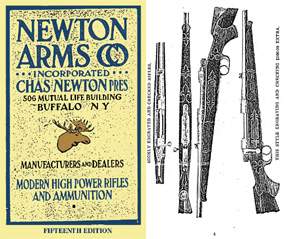This site uses cookies to ensure that you get the best experience on our website.
Keyword Search
Limit Search to 1 or 2 Words
Browse by Category
Narrows Your Search
A lawyer and firearm enthusiast, Charles (Chas.) Newton’s experiments with cartridge design led to the creation of the .22 Savage Hi-Power rifle cartridge which was adopted by the Savage Arms Corporation as a commercial firearm cartridge. This success was soon followed by the design of the .250-3000 Savage. At this period in time, Charles also experimented with wildcats based on the .30-06 Springfield case, most notably creating a forerunner of the .25-06 Remington. This cartridge was first introduced as the .25 Newton Special. There were probably no firearms produced in this caliber by Netwon. It soon evolved into the .256 Newton designed to use, at first, a 123 grain bullet followed by later upgrades to 129 grain and 140 grain bullets. Newton’s premise was to use a large case for each caliber he developed in order for the larger powder charge to propel the bullet at high velocity resulting in effective terminal ballistics. Newton developed several calibers. The best known are the .22 Newton (90 grain bullet), .256 Newton, .30 Newton (180 grain bullet), .33 Newton (200 grain bullet), .35 Newton (250 grain bullet) and .40 Newton (300 grain bullet). From 1914 until the late 1920s, he entered into various endeavours to promote and sell rifles in his proprietary calibers.
To promote his proprietary cartridges and ensure a supply of high-quality rifles capable of safely withstanding the high chamber pressure developed by them, Charles incorporated the Newton Arms Co. Inc. in 1914. The earliest of many catalogs issued by Newton offered Mauser and Sauer- Mauser rifles converted, probably by Fred Adolph, to Adolph and Newton calibers. Fred Adolph was a gunsmith in Genoa, New York. He and Newton worked together to design some of the early calibers. These cartridges were initially named Adolph calibers and later named using Newton in place of Adolph. In 1914, Charles Newton made arrangements with Mauser to import rifles in 6.5 caliber in order to convert them in the US to .256 Newton. One order of 24 rifles arrived in August 1914 and three more orders were never received due to the start of WWI.
The outbreak of World War I led Charles to manufacture his own rifles. With the employment of noted barrel-maker and gunsmith Harry Pope, Newton assured his rifles would be of the highest quality. These First Model 1916 rifles were made in Buffalo, New York. Due to financial difficulties and the inability to make ammunition because of the war efforts, the company produced rifles under Newton for 16 months. In this time, about 2400 rifles were manufactured. Newton Arms Co. Inc. went into receivership for the next 98 days. The receiver then sold out to a dealer in used factory equipment who in turn sold the equipment and left over rifles to the Newton Arms Corporation based in New York, New York. They were also in business about 16 months, were sued by Newton and sold the remaining rifles to Kirkland Bros Hardware.
Approximately 1600 rifles were sold by Newton’s successors making the total number of Model 1916s produced equal 4000 rifles. Newton started the Chas. Newton Rifle Co. in 1919 and imported about 100 German made Sauer-Mauser rifles, all in .256 Newton caliber. This model is known as the Model 1922 Newton. The Buffalo Newton Rifle Co. was organized in 1923 for the purpose of manufacturing a newly designed rifle. The first rifles were made in 1924 and became the Second Model 1924 Buffalo Newton rifle. The factory was in New Haven, Connecticut. Only about 1000 of this model Newton rifle were produced. Charles Newton’s last attempt at rifle manufacture was the LeverBolt rifle which never reached production status and only prototypes were made. Newton’s innovative rifle and cartridge designs contributed much to the firearms industry and some of his developments are used today by rifle makers.
Note: instructions only; this text box is not visible to visitors.
In the block BELOW, replace the CATEGORY SLUG between the quotes ” ” with the correct slug for the manufacturer, which can be found at: https://cornellpubs.com/wp-admin/edit-tags.php?taxonomy=product_cat&post_type=product













Some other catalogs featuring Buffalo Newton Rifle products:
We do NOT sell GUNS. We do NOT sell PARTS. We do NOT offer GUN VALUES. We do not represent any gun makers or sellers.
Subscribe to Our Newsletter
Subscribe to Our Newsletter
Subscribe to Our Newsletter
© 2003 – 2023 Cornell Publications LLC | All rights reserved
This site uses cookies to ensure that you get the best experience on our website.